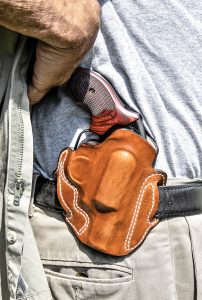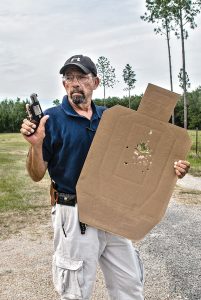Factory specified pull weight is 9.5-10.5 pounds. Our test K6S CDP, averaged 9.61 pounds pull weight when weighed low on the trigger on a Lyman digital trigger pull scale. Weighed from the center of the trigger, pull weight went over the gauge’s twelve-pound max. That said, though, I and all the other testers found it smooth and controllable.
Shooting the K6S
With any small-frame revolver, you have to worry that trigger reach may actually be too short, short enough that some part of the support hand or even the thumb of the firing hand if curled down could actually block the index finger from completing a pull of the trigger. My hand is “average adult male” in terms of finger length, and with the shooting hand’s thumb tucked down, the digits would touch as the shot broke. In two-hand shooting however with the support hand in a curled down thumb-print over thumb-nail grasp, the support hand’s thumb did block the trigger.

By the end of the test, I had reverted to an old habit with very small yet powerful revolvers: the thumb of the support hand crossed over the back of the firing hand. Not ideal with a full-size revolver and horrible with a semiautomatic, this grasp works with small-frame revolvers for two reasons: it gets the support hand thumb completely out of the way of the trigger finger, and it bonds the two hands together and prevents the need for re-gripping between shots as you deal with the jack-hammer recoil of full-power .357 Magnum ammo in a very small, relatively light gun (23 oz. empty). YouTube video of the world’s top revolver shooter, Jerry Miculek, shows him firing a J-frame Smith & Wesson with a thumb cross-over grip that he doesn’t use with any other firearm.
Recoil is nothing to worry about with standard pressure .38 Special loads, requires a firm grasp and some skill and experience with .38 Special +P, and is controllable but no fun at all with full power .357 “Mangle-‘em” ammo. As noted above, “kick” is sharp enough to separate the hands when rapid firing Magnums if you aren’t really on your game.
Accuracy
I know it is in vogue for gun writers to test these pocket size guns at fifteen, ten, or even seven yards on the theory that they’re short range weapons, but I still use the 25-yard line for two reasons. One, it is standard now for service handguns, and two, the pocket gun may have to be used for a service gun’s job in self-defense. An MTM rest on a concrete bench was used, with three different types of ammo.
Remington-UMC .357 Magnum 125-grain semi-jacketed hollow point is rated for 1,450 feet per second from a four-inch service revolver and can be expected to hit somewhere in the 1,200 fps range out of a two-inch gun like the K6S. Recoil and blast are nasty, but so is destruction on the other end. When state troopers in Kentucky and Indiana told me of the awesome effectiveness of such rounds, they didn’t distinguish between whether the shot was fired from a uniformed trooper’s four-inch S&W or a detective’s two-and-a-half-inch Combat Magnum. The five shots went into 2.75” center to center, and the best three were in 1.35”.

A whole lot of folks carry these baby Magnums with lighter-kicking .38 Special +P, and for that we used what is widely considered the most effective such load from a 2-inch barrel, the Speer 135-grain Gold Dot +P. Its group was wider, 6.05” for five shots. The rule of thumb is that 4” at 75’ = “acceptable service pistol accuracy,” with more slack cut for snubbies like this one; the “best three” cluster hit that with 2.75”. For those who came in late, we’ve found that the “best three” measurement factors out enough human error from hand-held bench rest shooting to roughly approximate what the same gun and ammo would do for all five from a machine rest.
The surprise—the shock, really—came with virgin Match 148-grain wadcutter .38 Special from Black Hills. This mild target load is approved by such luminaries as Dr. Gary Roberts from the wound ballistics world, and Chuck Haggard from the law enforcement sector, as a defense load in snub-nose .38s and .357s. From the bench, necessarily double action, the Black Hills loads cut a C-shaped one-hole group that measured 65/100ths of an inch center to center, too tight to accurately measure the best three within it! What’s more, it was relatively centered at 6 o’clock under the aiming bull, exactly where I was holding the post-in-notch sight picture. I wouldn’t have believed it if I hadn’t seen it.
On the Clock

To test the ergonomics when speed counted, I used a full blue box of Black Hills remanufactured wadcutter loads and ten .38 +Ps, hoping that through the good offices of Dr. Roberts and Brother Haggard I could use mostly light loads without getting my Man Card revoked. My first K6 came with a proprietary speedloader, but this one didn’t, so I reloaded on the timer two rounds at a time from 2X2X2 pouches by DeSantis and Galco. This necessitated some faster work on the trigger. Aided by the absolutely superb “big picture/low profile” sights, I was able to shoot 300 out of 300. Not bad for a small frame snubby. When I forgot to cross the support thumb over the back, though, my trigger finger hit my support hand thumb and pushed a couple of shots high, though none out of the “A” zone. The solid, all-steel heft of the K6S, while a bit saggy in pocket carry and not the most comfortable on the ankle, does reduce recoil discomfort and muzzle jump.




















